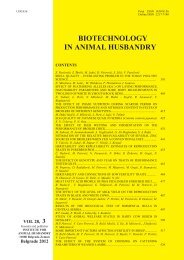Biotechnology in Animal Husbandry - Institut za Stočarstvo
Biotechnology in Animal Husbandry - Institut za Stočarstvo
Biotechnology in Animal Husbandry - Institut za Stočarstvo
Create successful ePaper yourself
Turn your PDF publications into a flip-book with our unique Google optimized e-Paper software.
280<br />
M. Bojanić-Rašović et al.<br />
ripen<strong>in</strong>g 11.020%. For the total period of ripen<strong>in</strong>g 30-60 days average value for<br />
weight loss of cheese amounted to 5.507% (Tables 3 and 4).<br />
Compared to the traditional ripen<strong>in</strong>g, Kir<strong>in</strong> (2002) found slightly lower<br />
weight loss dur<strong>in</strong>g ripen<strong>in</strong>g of cheese covered by protective grease (7.694%),<br />
and lowest weight loss dur<strong>in</strong>g the ripen<strong>in</strong>g of cheese <strong>in</strong> a plastic bag (0.176%).<br />
The author further found that the weight loss of cheese covered with protective<br />
grease was also highest <strong>in</strong> the first 10 days of ripen<strong>in</strong>g.<br />
The highest possibility of <strong>in</strong>fluence on the weight of cheese is <strong>in</strong> the first<br />
stage of ripen<strong>in</strong>g (Kir<strong>in</strong>, 2002). However, our results show that period of ripen<strong>in</strong>g<br />
10-20 days is also important for weight loss of cheese.<br />
In our research we obta<strong>in</strong>ed the middle positive correlation between of<br />
somatic cells count <strong>in</strong> milk and weight loss of cheese <strong>in</strong> period 1-10 days of<br />
ripen<strong>in</strong>g (0.69156) and middle positive correlation (0.767336) between the total<br />
bacteria count and weight loss of cheese <strong>in</strong> period 1-10 days of ripen<strong>in</strong>g (Table<br />
6.) These results can be attributed to the negative <strong>in</strong>fluence of somatic cells and the<br />
total bacteria count on the quality of milk, and thus the composition and properties<br />
of the produced cheese. Changes <strong>in</strong> the composition of milk, which are correlated<br />
with an <strong>in</strong>crease of the somatic cells count <strong>in</strong> milk, significantly affect the<br />
coagulation time, curd firmness, <strong>in</strong>creased activity of bacteria, changed the taste of<br />
the f<strong>in</strong>ished product and reduced yield of cheese (Niketić et al., 2003).<br />
Effect of somatic cells count and the total bacteria count on weight loss of<br />
cheese can best be shown through the example of the results for weight loss of<br />
cheese of production l<strong>in</strong>e number 11, which was significantly higher (7.594% <strong>in</strong><br />
the period 1-10 days, or 13.541% <strong>in</strong> the period 1-30 days of ripen<strong>in</strong>g) compared to<br />
the value of weight loss of cheese other production l<strong>in</strong>es (Table 3). Milk for<br />
production of this cheese had the highest somatic cells count (614.000/mL milk)<br />
and the highest total bacteria count (6.727.000/mL).<br />
Changes <strong>in</strong> chemical composition and physical properties of milk caused<br />
by mastitis cause the appearance of prolonged coagulation time and a lower<br />
hardness of curd. Low hardness of curd after cutt<strong>in</strong>g leads to loss of small curd<br />
particules. Decomposition of milk case<strong>in</strong> also affects the process of syneresis<br />
dur<strong>in</strong>g mak<strong>in</strong>g of cheese and thus result <strong>in</strong> <strong>in</strong>creased moisture content (Barbano,<br />
2000).<br />
Somatic cells count <strong>in</strong> milk positively related to moisture <strong>in</strong> nonfat<br />
substances of cheese. Curd moisture <strong>in</strong>creased with <strong>in</strong>creas<strong>in</strong>g SCC <strong>in</strong> milk<br />
(Politis and Ng-Kwai-Hang, 1988a).<br />
No significant trend between of somatic cells count and actual yield of<br />
cheese. In the case of actual yield, the high moisture content masked the results<br />
(Politis and Ng-Kwai-Hang, 1988b). Our results showed that there is not<br />
correlation between somatic cells count and actual yield of cheese, too (Table 6).




